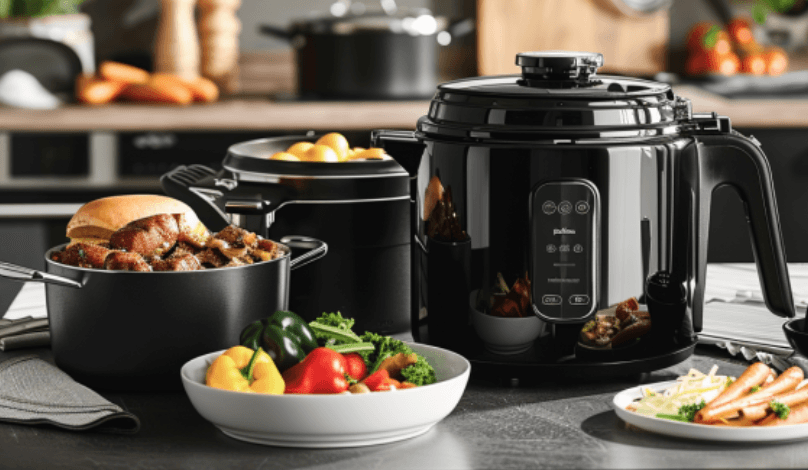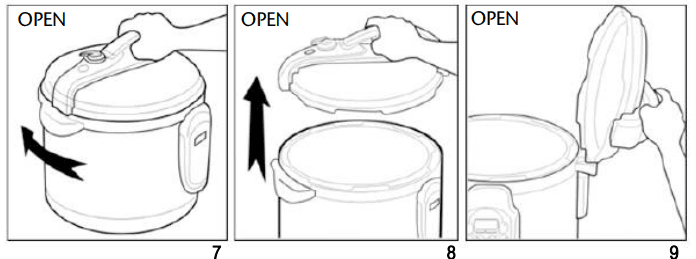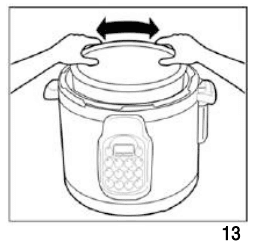
Cooks Essentials EPC-678 Digital Pressure Cooker
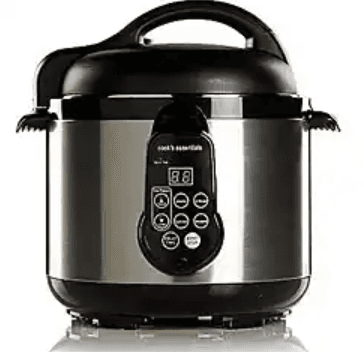
IMPORTANT SAFEGUARDS
When using pressure cookers, basic safety precautions should always be followed:
Read all instructions before operation.
- Do not operate while unattended.
- Do not touch hot surfaces. Use handles or knobs.
- Close supervision is necessary when the pressure cooker is used near children.
- DO NOT allow children to operate under any circumstance.
- Do not place the pressure cooker in a heated oven or on a stovetop.
- Extreme caution must be used when moving a pressure cooker containing hot liquids.
- Do not use a pressure cooker for other than intended use.
- Never immerse the product in water or other liquids.
- This appliance cooks under pressure. Improper use may result in serious injury.
- Make certain the unit is properly closed before operating. See Operating Instructions.
- Do not fill the unit over 3/4 full. When cooking foods that expand during cooking such as rice or dried vegetables, do not fill the unit over 1/2 full. Overfilling may cause a risk of clogging the vent pipe and developing excess pressure. Failure to follow this procedure can result in injury to a person(s) and/or damage to the unit.
- Be aware that certain foods, such as applesauce, cranberries, pearl barley, oatmeal or other cereals, split peas, noodles, macaroni, rhubarb, or spaghetti can foam, froth, sputter, and clog the pressure release device (steam vent). These foods should not be cooked in a pressure cooker.
- Always check the pressure release devices for clogging before use.
- Do not open the pressure cooker until the unit has cooled and all internal pressure has been released. If it is difficult to turn, this indicates that the cooker is still pressurized – do not force it open. Any pressure in the cooker can result in serious injury. See Operating Instructions.
- Do not use this pressure cooker for pressure frying with oil.
- DO NOT place the product near flammable materials or use it in a humid environment.
- DO NOT damage the Rubber Seal Ring and DO NOT replace it with anything other than the replacement Ring designated for this unit.
- DO NOT tamper with the Steel Ring in the Lid with any tools or external forces. If the Steel Ring is damaged, please stop using it immediately and replace the Lid.
- Clean the Filter regularly to keep the cooker clean
- NEVER use additional weight on the Pressure Release Valve or replace the Pressure Release Valve with anything not intended for use with this unit.
- The surface of contact between the Inner Pot and the Electronic Heater should always be clean. DO NOT use the Inner Pot with other heating 22) sources. DO NOT replace the Inner Pot with a container other than what is recommended by the manufacturer.
- The Inner Pot consists of a non-stick surface. To avoid scratching the non-stick surface, please use wooden or plastic utensils.
- Food should not be kept warm for more than 8-10 hours in order to maintain the freshness of the food.
- The pressure cooker should not be used for pressure cooking for more than 6 hours continuously.
- Serious Injury and/or damage may occur if any safeguards are ignored.
- If steam escapes around the Lid during the cooking process, please unplug from the power supply immediately, let it cool, remove contents and return the product to the manufacturer for exchange or repair. The Pressure pressure-discharging device has been activated. This is a safeguard to alert the user that the Pressure Release Device is malfunctioning.
- If there is any malfunction of the cooker during the cooking process, please stop using the device and return it to the manufacturer for repair or exchange.
- DO NOT disassemble the product, or replace parts with parts not intended for this unit.
SAVE THESE INSTRUCTIONS HOUSEHOLD USE ONLY
SAFETY WARNING: There is a potential risk of fire, electric shock, or injury to persons if the product is not used as instructed. Protection against electric shock is assured only if the main power cord is connected to a properly grounded 110-120V | 50/60Hz power receptacle.
- This product is to be used in an indoor environment only and is not intended for commercial use.
- All parts and accessories for this appliance must be used properly according to the instructions. All parts and accessories must be the original provided by the manufacturer. All parts or accessories not intended for use with this appliance are strictly prohibited.
- The use of an extension cord, power adapter, or other electric devices is not recommended.
ERROR CODES
| Indicator Code | Problems/Causes |
| E1 | Open Circuit of the Sensor |
| E2 | Short Circuit of the Sensor |
| E3 | Overheating |
| E4 | Signal Switch Malfunction |
SHORT CORD PURPOSE
NOTE: A short power cord is provided to reduce the risk of personal injury resulting from becoming entangled in or tripping over a longer cord. Longer power-supply cords or extension cords are available and may be used if care is exercised in their use.
If an extension cord is used:
- the marked electrical rating of the extension cord should be at least as great as the electrical rating of the product;
- the extension cord should be arranged so that it will not drape over the countertop or tabletop where it can unintentionally be pulled on or tripped over by children or pets.
POLARIZED PLUG
If this appliance is equipped with a polarized plug (one blade is wider than the other), please follow the below instructions: To reduce the risk of electrical shock, this plug is intended to fit into a polarized outlet only one way. If you are unable to fit the plug into the electrical outlet, try reversing the plug. If the plug still does not fit, contact a qualified electrician. Never use the plug with an extension cord unless the plug can be fully inserted into the extension cord. Do not alter the plug of the product or any extension cord being used with this product. Do not attempt to defeat the safety purpose of the polarized plug.
PARTS IDENTIFICATION
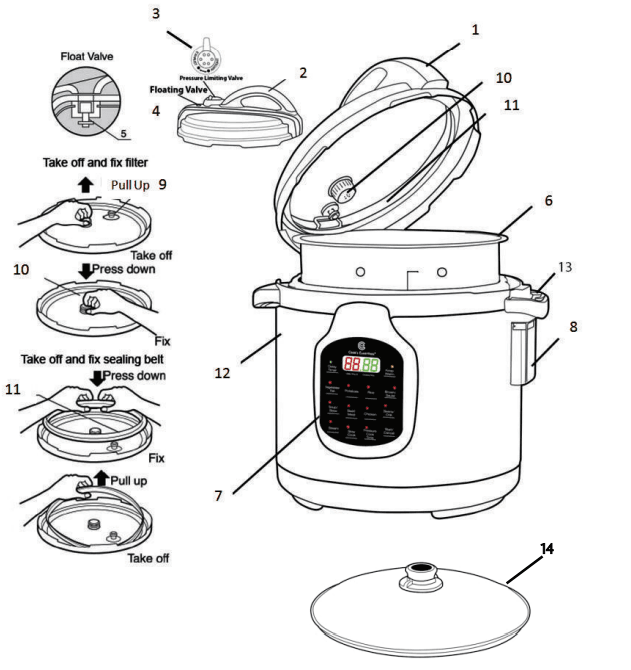
- Lid
- Handle
- Pressure Limiting Valve
- Float Valve (External View)
- Float Valve (Internal View)
- Non-stick Inner Pot
- Control Panel
- Condensation Collector (Snaps On)
- Seal Ring for Float Valve
- Filter
- Rubber Seal Ring for Lid
- Body Cover/Structure
- Lid Rest (Lid latches onto the side handle)
- Glass Lid (to be used with the SLOW COOK and STEAM functions)
GLASS LID ASSEMBLY
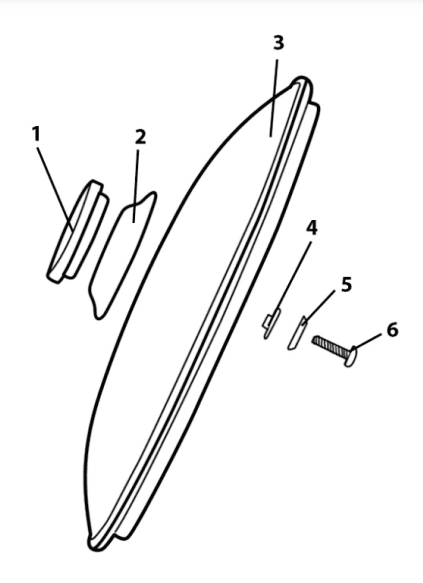
**Your Pressure Cooker is equipped with a Tempered Glass Lid (14) that can be used with the SLOW COOK and STEAM functions. Please do not use this Glass Lid (14) with any other functions on this Pressure Cooker.
Assembly of the Knob on the Glass Lid will require a Phillips Screwdriver (not included). Follow the diagram on the left to assemble the knob on the Glass Lid (14).
- Handle
- Handle Base
- Glass Lid Body
- Silicon Gasket
- Gasket
- M4 Screw
PRESSURE COOKER LID MARKINGS
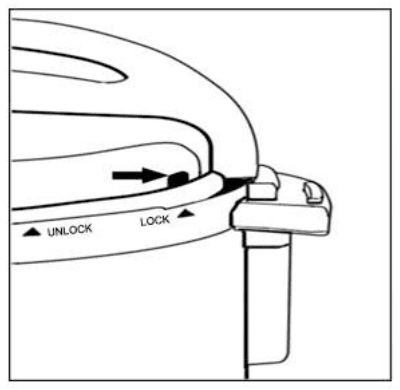
Please note the “LOCK” and “UNLOCK” markings on the rim of your pressure cooker body (12). To properly close and secure the pressure cooker lid (1), always line up the tab on the lid (1) with the “LOCK” arrow marking indicated on the rim of your pressure cooker body (12).
BEFORE FIRST USE
| Working Pressure | PSI | Maximum Pressure | Keep Warm Temperature | Delay Timer |
| 0~70kPa | 12 PSI | 90kPa | 140ºF ~ 175 ºF | 0.5~24 Hours 0.5 Hour Increments up to 10 hours thereafter 1-hour increments |
- Remove packaging materials such as cardboard, plastics or Styrofoam and discard appropriately.
- Clean all the parts by wiping with a soft damp cloth or sponge and dry thoroughly.
LID ASSEMBLY:
How to open the lid: Hold the handle (2) firmly, turn the lid (1) clockwise until it loosens and lift vertically.(Figures 1-2); the lid (1) can stand on the Lid Rest (13) (Figure 3).
Note: For new units, the seal of the lid (1) may be slightly stronger than normal and may be slightly difficult to unlock. Once the lid (1) has been opened and closed several times, it will loosen up.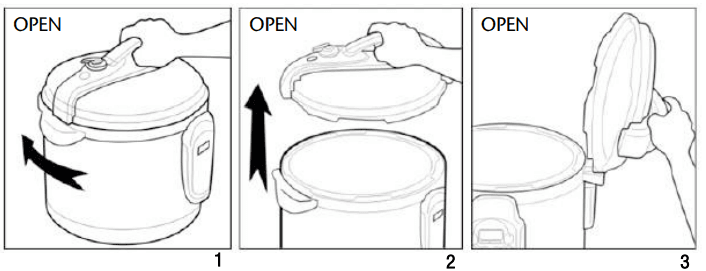
How to close the lid: Take the lid (1) off the lid rest (13) (Figure 4), hold the handle (2) and close it downwards at the Opened Lid position (Figure 5). Turn counter-clockwise until you reach the Closed Lid position. (Figure 6).
PREPARING YOUR PRESSURE COOKER
- Opening the lid: Hold the handle (2) firmly, turn the lid (1) clockwise until it loosens and lift vertically. (See Figures 7-8); the lid (1) can stand on the lid rest (13) (Figure 9).

- Remove the inner pot (6) and add desired ingredients. The amount of water and food should not exceed 4/5 of the height of the inner Pot (6) (Figure 10). For food that will expand in water, the level should not exceed 3/5 of the Inner Pot (6) (Figure 11). The minimum level for cooking would be 1/5 of the Inner Pot (6) (Figure 12).

- Be certain the inner receptacle, where the Electronic Heater is located, is clean and dry before inserting the Inner Pot (6) into the pressure cooker and adjust the pot left and right to ensure optimal contact between the Inner Pot and the Electronic Heater ( Figure 13).

- Closing the Lid: Make sure the Rubber Seal Ring (11) is fitted properly onto the inner part of the lid (1). Observe the Rubber Seal Ring (11) inside the Lid (1) and ensure that it is evenly fitted onto the track. (Caution: If the rubber seal ring is damaged, do not use the pressure cooker. Contact Customer Service to repair or replace.)
- Lift the lid (1) from the rested position. Close the lid (1). Hold the handle (2) and turn it counterclockwise to the “LOCKED” position. (A clamping sound can be heard See Figures 14-16).

- Adjust the pressure limiting valve (3) to the “Airtight” position, and ensure that the Float Valve (4) sinks (Figures 17-18).
- When adjusting the pressure limiting valve (3) to either the “Airtight” or the “Exhaust” positions, line up the marking on the pressure limiting valve (3) with the notch on the Handle (2) as shown in Figure 19.

NOTES & TIPS #1:
- Please note that the Pressure Limiting Valve (3) will be loose when you are not using the unit for cooking. It will rock slightly and will turn 360° manually. Once the pressure cooker is in operation and the pressure has built up to its capacity, the Pressure Limiting Valve (3) will tighten, only allowing itself to be turned to “Exhaust”. Once all the pressure has been released, it will become loose again.
NOTES & TIPS #2:
- During the Pressure-building process, you may notice steam or pressure escaping from the Pressure Limiting Valve (3). Carefully adjust the valve by moving it gently or turning it side to side gently using tongs or similar utensils until it seals properly.
- If any steam is escaping around the lid, it means that the Rubber Seal Ring(11) may not have completed a tight seal when the lid (1) was locked. Cancel the cooking process, release pressure manually or naturally, remove the lid (1), and check the Rubber Seal Ring (11). Reposition the lid (1) and ensure that it is secure. Re-start the cooking process.
- Please note that steam escaping from the Valve (3) or around the lid (1) is normal for the first 5 minutes or so of the cooking process. If it continues beyond 10 minutes, please press the Cancel button and follow the instructions to release all of the pressure before removing the lid (1) to check the Valve (3) or the Rubber Seal Ring (11).
NOTES & TIPS #3:
**At any point during the selection process or the cooking process, you can press the CANCEL button to cancel your selection or to cancel the cooking process.
OPERATING INSTRUCTIONS
HOW TO USE THE PRE-SET MENU BUTTONS:
There are Seven Pre-set Menu Buttons pre-programmed for your pressure cooker (Vegetables/Fish, Soup/Stew, Potatoes, Beef/Meat, Rice, Chicken, and Beans/Chili). These are pre-set for quick and easy cooking for small portions of food in addition to manual programming. (When cooking food that is more than 3lbs. or more than 6 cups, please use the Timed Cooking function under ‘HOW TO USE THE PRESSURE COOK TIME BUTTON.’)
The seven Pre-set Menu Buttons are programmed to detect the weight of the food being cooked and how much liquid is inside the pot during the cooking cycle. The unit will automatically build up the pressure, cook the food, and go to KEEP WARM when cooking is complete.
| MENU BUTTON SELECTIONS & COOK TIMES: | |||
| VEGETABLES/FISH | 5-minutes | BEANS/CHILI | 14-minutes |
| SOUP/STEW | 16-minutes | PRESSURE COOK TIME | 1~99-minutes |
| POTATOES | 12-minutes | STEAM | 1~40-minutes |
| BEEF/MEAT | 26-minutes | SLOW COOK | 0.5~9.5-hours |
| RICE | 10-minutes | BROWN/SAUTE | – |
| CHICKEN | 20-minutes | ||
- Prepare desired food and place into the cooking pot (6).
- Secure the lid (1) onto the unit, and turn it Counter-clockwise to lock it properly in place.
- Make sure the Pressure Limiting Valve(3) is set to the “Airtight” position.
- Plug the power cord into a 120V power outlet.
- The LED screen will display 0.0 00.
- Choose the desired menu button. When pushed, the Cook Time will display for the selected setting. For example, if VEGETABLES/FISH is selected, the display will show 0.0 05 and the indicator light for VEGETABLES/FISH will begin blinking. Press START to begin the cooking process and the indicator light for VEGETABLES/FISH will turn solid.
- Once you press START, the LED screen will display T TP. You may press CANCEL to stop the current cooking function.
- The pressure cooker will begin building pressure at this time. Using the VEGETABLES/FISH function as an example, the LED screen will display P0 05 when proper pressure is achieved and the 5-minute cook-time will begin to count down. (Depending on the menu button selected, the display will be different for each button and show P0__ correspondingly based on the MENU BUTTON SELECTIONS& COOK TIMES CHART.
- When the unit has pressurized, it will begin to pressure-cook the food. You may hear quiet hissing or sizzling sounds coming from inside of the unit during this time.
- When cooking has completed, the pressure cooker will beep 6 times and automatically go to KEEP WARM. The LED Screen will display END.
- The KEEP WARM indicator light will begin blinking and the Pressure Cooker will begin naturally releasing the pressure. (See Notes & Tips #6). This will take approximately 10-15 minutes. Once all pressure has been released the KEEP WARM indicator light will turn solid.
- You may also quickly release the pressure. If you wish to quickly release the pressure, move the Pressure Limiting Valve (3) to the “Exhaust” position to release the pressure until the Float Valve (4) sinks. (Figures 20-21)

- Always be certain the pressure is released completely before unlocking the lid (1) and opening it.
- Press CANCEL to end operation and remove food to serve immediately or allow the unit to remain in KEEP WARM mode. (It is not recommended to keep food warm for over 4 hours).
CAUTION: Use an oven mitt or a long utensil. Keep hands, arms, and face away from the Pressure Release Valve while in the Exhaust position. Failure to comply may cause serious injury.
NOTES & TIPS #4:
- When pressing a Menu Button, the LED screen will not immediately change until the pressure has built up to capacity. This may take approximately 5-10 minutes depending on the quantity of food you are cooking.
NOTES & TIPS #5:
- When cooking soups or stews with other hearty ingredients such as potatoes or meat, as much as 5 or 6 cups of liquid must be used to prevent ingredients from over-cooking or burning.
NOTES & TIPS #6:
- NATURAL RELEASE is recommended when cooking foods that will not have the tendency to overcook such as Potatoes, Beans, Soups & Stews. During the Natural Release time period (which may take 10-15 minutes), the pressure cooker may still be heated and cook the food slightly.
- QUICK RELEASE is recommended when cooking foods that you wish to be Medium or Medium-Rare such as Beef Roasts or Lamb. This will release the pressure quickly and prevent the food from overcooking.
HOW TO USE THE SET PRESSURE COOK TIME BUTTON:
Setting your own cook time is ideal for cooking meat or poultry that weighs more than 3 pounds. It is also suggested for slow-cooking certain recipes that require cooking for more than 30 minutes. The programmed cook time can be set up to 99 minutes.
- Prepare desired food and place into the cooking pot (6).
- Secure the lid (1) onto the unit, and turn it Counter-clockwise to lock it properly in place.
- Make sure the Pressure Limiting Valve(3) is set to the “Airtight” position.
- Plug the power cord into a 120V power outlet.
- The LED screen will display 0.0 00.
- Set the desired cooking time by pressing the PRESSURE COOK TIME button. Each push of the Pressure Cook Time button will increase the cooking time by 1 minute or hold the button down for a rapid increase of time. The maximum amount of time allowed is 99 minutes.
- For example, if you set the PRESSURE COOK TIME to 18 minutes, the LED screen will display 0.0 18.
- Press the START button to start cooking, the indicator light for PRESSURE COOK TIME will stop blinking and the display will show T TP. When proper pressure is achieved, the LED screen will display P0 18 (As an example, we’ve set the cooking time to 18 minutes) and the cooking time will begin to count down to 0. (Note: The LED screen will not immediately display a P until the proper pressure has been achieved. This may take up to 5-10 minutes).
- When cooking is complete, the pressure cooker will beep 6 times and automatically switch to KEEP WARM. The LED screen will display END.
- The KEEP WARM indicator light will begin blinking and the Pressure Cooker will begin naturally releasing the pressure. (See Notes & Tips #6). This will take approximately 10-15 minutes. Once all pressure has been released the KEEP WARM indicator light will turn solid.
HOW TO USE THE DELAY TIMER BUTTON:
If you wish to program your pressure cooker to automatically cook prepared food at a later time, you can program the pressure cooker to delay cooking by up to 24 hours. This setting is used in combination with the MENU BUTTON SELECTIONS in the chart shown on page 12 with the exception of the BROWN/SAUTE function.
- Prepare desired food and place into the cooking pot (6).
- Secure the lid (1) onto the unit, and turn it Counter-clockwise to lock it in place.
- Make sure the Pressure Limiting Valve(3) is set to the “Airtight” position.
- Plug in the power cord to a 120V outlet.
- The LED screen will display 0.0 00.
- Press the DELAY TIMER button (the indicator light will begin blinking), pressing it once for each additional 0.5-hour or hold for a rapid increase of up to 10 hours, thereafter 1-hour increments (indicated on the LED screen). The maximum Delay period is 24 hours in half-hour increments. Pressing the delay timer button again after reaching the 24-hour setting will automatically reset the delay timer to zero. (The time that displays on the LED screen shows how long the user wants the unit to wait before the cooking process begins.) EX: If you wish to program the pressure cooker to automatically turn on in 3 hours, press the DELAY TIMER button, then press the DELAY TIMER
button 5 more times until the LED screen displays 3.0 00). - After choosing the desired delay time, choose your MENU BUTTON or PRESSURE COOK TIME.
- MENU SELECT BUTTONS
- Select one of the ten MENU BUTTONS and then press START.
- Once you have selected your desired function, the pressure cooker will count down the delay time and then start cooking.
- PRESSURE COOK TIME::
- Press the PRESSURE COOK TIME button to the desired cook time. EX: If you wish to program to cook for 60-minutes. The LED screen will display 3.0 60).
- Press START. Your pre-set delay timer has been programmed to delay cooking by 3 hours and to cook for 60 minutes.
- MENU SELECT BUTTONS
- Once you have pressed START, both the indicator lights for the DELAY TIMER and the COOK FUNCTION will illuminate the solid.
- When cooking has been completed, the pressure cooker will beep 6 times and automatically go to Keep Warm mode. The display will read “END.”
- The KEEP WARM indicator light will begin blinking and the Pressure Cooker will begin naturally releasing the pressure. (See Notes & Tips #6). This will take approximately 10-15 minutes. Once all pressure has been released the KEEP WARM indicator light will turn solid.
NOTES & TIPS #7:
- It is recommended to release the pressurized steam when the “Keep Warm” LED stops flashing as the pressure cooker will have lower pressure. This will require a little more time. (Approximately 5-10 minutes).
- During the cooking process, when the pressure cooker enters into the Pressurized Sequence, the first digit on the LED screen will display the letter “P”.
- For foods with a high volume of liquid (Stews, soups, porridges, etc.) IT IS NOT RECOMMENDED TO USE QUICK RELEASE. This is to avoid liquid splatter from the ventilation in the Pressure Limiting Valve (3).
- Using NATURAL RELEASE: The user should wait for the temperature to drop and the Float Valve (4) to sink on its own prior to opening the lid.
*CAUTION: It is not recommended to use the Delay Timer function to cook foods that may spoil. Leaving raw foods inside the pressure cooker for long periods of time prior to cooking may result in food spoiling. Cook food that can be left out such as rice, beans, grains or other foods that will not spoil.
CLEANING & MAINTENANCE
- Always make sure the Pressure Cooker is unplugged, depressurized and completely cooled down before cleaning or dismantling.
- Use a non-abrasive sponge or damp wash cloth to clean the exterior of the outer body (12) and the exterior surface of the pressure cooker. NEVER immerse the pressure cooker in any liquids.
- Remove the Condensation Collector (8)and rinse it thoroughly and let dry. Clean the Upper Body (12) with a damp sponge or wash cloth.
- Clean the Lid (1) with warm soapy water, including the Rubber Seal Ring (11), Pressure Limiting Valve (3), Filter (10), Vent, and Floating Valve (4) and let dry thoroughly.
- The Pressure Limiting Valve (3) pops off easily by gently reaching underneath it and gently prying upwards. Be careful not to damage the thin wire spring under it.
- On the underside of the lid (1) below the Pressure Limiting Valve (3) is a small metal Filter cap (10) which can be removed easily to clean.
- Let parts dry completely before reassembling.
- Wash the Inner Pot (6) with a non-abrasive sponge with warm soapy water, rinse, and allow to air dry or use a towel.
- Clean the Pressure Limiting Valve (3) and the holes with a small brush to ensure smooth flow of steam during the release cycle.
NOTE: Any servicing required shall be performed by an authorized service representative or from the original manufacturer or distributor.
How to Clean the Filter:
If you wish to clean the filter (10), you may remove it by pulling vertically. To re-attach, simply line up the filter (10) and press down to secure the filter (Figure 22).
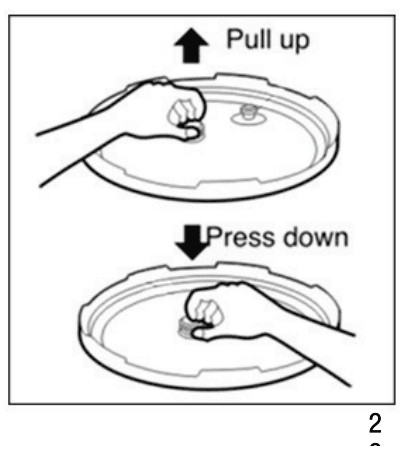
COOKING TIME CHART
Please note that all the below information is for your reference only and can be adjusted according to the user’s preference.
Meat/Poultry
- Always cook meat or poultry with at least 1-3 cups of liquid. If the cooking time exceeds 15 minutes, use 2 cups of liquid. If weight of meat or poultry is 3lbs, use 3 cups of liquid. Preserved or salted meats should be immersed in water.
- Cooking times for meat and poultry may vary according to the quality and quantity of meat or poultry being cooked.
- Unless indicated. The cooking times given below are for 3 pounds of meat or poultry unless noted
otherwise. Additionally, the denser the cut, the longer the cooking time should be.
| Type of Meat | Approximate Cooking Minutes | Pressure Release |
| Beef/Veal, roast or brisket | 38-42 | Quick Release |
| Beef Meatloaf, 2 lbs. | 13-18 or use the Meat Button | Quick Release |
| Beef, meatballs, 1-2 lbs. | 7-12 or use the Meat Button | Natural Release |
| Beef, Corned | 55-65 | Natural Release |
| Pork, roast | 43-47 | Natural Release |
| Pork, ribs, 2 lbs. | 18 or use the Meat Button | Quick Release |
| Pork, ham shank | 25-28 | Natural Release |
| Leg of Lamb | 42-45 | Natural Release |
| Chicken, whole, 2-3 lbs. | 15-18 or use the Meat Button | Quick Release |
| Chicken, pieces, 2-3 lbs. | 12-15 or use the Meat Button | Quick Release |
| Cornish Hens, two | 12-15 or use the Meat Button | Quick Release |
| Meat/Poultry soup/stock | 15-20 or use the Meat Button | Quick Release |
Seafood
- Cooking times may vary according to the type of seafood being cooked.
- Cook seafood on a cooking rack with a trivet on the bottom of the pot (if available), and add at least 3/4 cup of liquid. Lightly grease cooking rack with vegetable oil when cooking fish.
| Type of Seafood | Approximate Cooking Minutes | Pressure Release |
| Clams | 3-5 | Quick Release |
| Crabs | 3-5 | Quick Release |
| Lobster, 1 1/2 – 2 lbs. | 3-5 | Natural Release |
| Mussels | 3-5 | Quick Release |
| Shrimp | 2-3 | Quick Release |
| Fish, whole, gutted | 7-8 | Quick Release |
| Fish, Soup or Stock | 7-8 | Quick Release |
Vegetables
- Always cook with at least 1-2 cups of liquid.
- Add 1-2 additional minutes to cooking time when preparing frozen vegetables.
- Use the quick-release release method at the end of cooking cycle so vegetables will not become soggy. (Below chart is for quantity approximately half a pot).
| Type of Vegetable | Approximate Cooking Minutes | Pressure Release |
| Asparagus, thick whole | 2-5 | Quick Release |
| Asparagus, thin whole | 1-2 | Quick Release |
| Beans, fava, shelled | 5 | Quick Release |
| Beans, green, whole | 4-5 | Quick Release |
| Beans, lima, shelled | 3 | Quick Release |
| Beets, small, whole | 2-3 | Quick Release |
| Beets, large whole | 23 | Quick Release |
| Beets, 1-inch slices | 5 | Quick Release |
| Broccoli, flowerets | 3 | Quick Release |
| Brussel sprouts, whole | 5 | Quick Release |
| Carrots, 1-inch chunks | 5 | Quick Release |
| Carrots, 1/4-inch slices | 1-2 | Quick Release |
| Cauliflower, flowerets | 3-5 | Quick Release |
| Corn on-the-cob (4-6) | 4 | Quick Release |
| Escarole, coarsely chopped | 2-3 | Quick Release |
| Kale, coarsely chopped | 2-3 | Quick Release |
| Okra, small pods | 3-5 | Quick Release |
| Onions, whole | 3 | Quick Release |
| Potatoes, 11/2-inch chunks | 7 | Quick Release |
| Potatoes, new, small whole | 6 | Quick Release |
| Potatoes, sweet and yams, whole, medium | 10-12 | Quick Release |
| Potatoes, sweet and yams, 2″ chunks | 7-8 | Quick Release |
| Spinach, fresh, coarsely chopped | 3 | Quick Release |
| Squash, acorn, halved | 8 | Quick Release |
| Squash, butternut, 1-inch chunks | 5 | Quick Release |
| Squash, summer, zucchini or yellow, 1/2-inch slices | 6 | Quick Release |
| Turnips, small quartered | 4 | Quick Release |
| Turnips, 1 1/2 inch chunks | 4 | Quick Release |
*Split peas and rhubarb can foam, froth, and sputter, and can clog the pressure release device (steam vent). These foods should not be cooked in a pressure cooker.
Dried Beans and Other Legumes
- Place beans or legumes in pressure cooker. Add 3 cups of water for each cup of beans or legumes.
- Add 1 tablespoon of vegetable oil for each cup of water to cut down on foaming. Do not add salt until after cooking.
- Let pressure drop naturally after cooking.
- Cooking times may vary according to the quality of the beans or other legumes. If still hard after recommended cooking times, continue cooking uncovered. Add additional water, if necessary. (Below chart is for quantity approximately half a pot).
| Type of Legume | Approximate Cooking Minutes | Pressure Setting |
| Azuki | 7-8 | Natural Release |
| Black Beans | 10-12 | Natural Release |
| Black Eyed Peas | 11-12 | Natural Release |
| Chick Peas (garbanzo) | 11-13 | Natural Release |
| Gandules (pigeon peas) | 8-10 | Natural Release |
| Great Northern | 10-14 | Natural Release |
| Kidney Beans, Red | 12-14 | Natural Release |
| Lentils, green | 10-12 | Natural Release |
| Lentils, soup | 8-10 | Natural Release |
| Lentils, red | 10-15 | Natural Release |
| Lima Beans | 7-8 | Natural Release |
Meat/Poultry (Larger Cuts)
- Always cook meat or poultry with at least 1-3 cups of liquid. If the cooking time exceeds 15 minutes, use 2 cups of liquid. If weight of meat or poultry is 3lbs, use 3 cups of liquid. Preserved or salted meats should be immersed in water.
- Cooking times for meat and poultry may vary according to the quality and quantity of meat or poultry being cooked.
| Category | Meat | Pressure Cooker Cook Times (Approx) |
|
Beef, fresh | rib roast, bone in | 42-80 minutes cook time |
| (4 to 6 pounds) | ||
| rib roast, boneless, rolled | 60-90 minutes cook time | |
| (4 to 6 pounds) | ||
| round or rump roast | 30-45 minutes cook time | |
| (2 ½ to 4 pounds) | ||
| Turkey, fresh unstuffed | 4 to 8 pounds (breast) | 30-80 minutes cook time |
| 8 to 12 pounds | 35 to 45 minutes cook time | |
|
Chicken, fresh | whole roasting hen | 25 – 35 minutes cook time |
| (5 to 7 pounds) | ||
| breast, halves, bone-in | 8-15 minutes cook time or press MEAT button | |
| (6 to 8 ounces) | ||
| breast, halves, boneless | 6-10 minutes cook time or press MEAT button | |
| (4 ounces) | ||
| legs or thighs | 8-20 minutes cook time or press MEAT button | |
| (4 to 8 ounces) | ||
|
Pork, fresh | loin roast, bone-in or boneless | 25 – 50 minutes cook time |
| (2 to 5 pounds) | ||
| crown roast | 35 – 70 minutes cook time | |
| (4 to 6 pounds) | ||
| tenderloin | 8-15 minutes cook time or press MEAT button | |
| (½ to 1 ½ pounds) | ||
|
Ham, smoked | fresh, cook-before-eating, bone-in, half | 45 – 70 minutes cook time |
| (5 to 7 pounds) | ||
| fully cooked, bone-in, half | 35 – 60 minutes cook time | |
| (5 to 7 pounds) | ||
| fully cooked, spiral cut, whole or half | 50 – 85 minutes cook time | |
| (7 to 9 pounds) |
For more manuals by Cook’s Essentials, visit ManualsLibraryy
Cooks Essentials EPC-678 Digital Pressure Cooker-FAQs
How do I troubleshoot my pressure cooker?
Ensure the heating element in the cooker base and the underside of the inner pot are clean. Place the inner pot back in the base, close the lid securely, and set the steam release valve to the sealing position. Restart the cooking cycle, and your meal should cook properly.
What should I do if my pressure cooker isn’t working?
First, check the power supply to your cooker. For electric models, ensure the heating element is functioning. If it’s a gas cooker, the igniter may need attention.
What is a good PSI for a pressure cooker?
Electric pressure cookers typically operate at 12-12.5 PSI, while stovetop models can reach 15 PSI. At 12 PSI, food like vegetables and meats cook quickly and efficiently.
Is an electric pressure cooker better than a manual one?
Electric pressure cookers offer more features and don’t require constant monitoring like stovetop models, though they may cook slightly slower.
What’s the basic rule for using a pressure cooker?
Never fill the pressure cooker more than two-thirds full. For liquids, avoid exceeding half-full. Overfilling can cause food to clog the pressure release valve and affect cooking performance.
How can I tell if my pressure cooker is too full?
If the cooker is overfilled, food may escape through the pressure release valve. Ensure it’s no more than two-thirds full with food or half full with liquids to prevent this.
How much water should I use for cooking 2 cups of rice?
Use a 1:2 ratio of rice to water. For 2 cups of rice, add 4 cups of water.
Do rice cookers turn off automatically?
Yes, rice cookers automatically turn off once the rice is fully cooked, ensuring consistent results without overcooking.
Does a pressure cooker cook rice faster?
Yes, using the pressure cooking setting cooks rice faster than traditional stovetop methods, delivering consistent results each time.
When should I turn off my pressure cooker?
You can either let the pressure naturally release and wait for the lid-lock to disengage or wait 10 minutes after cooking and manually open the valve for a faster release. Both methods help keep food warm and tenderize meat.

